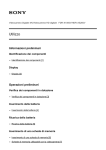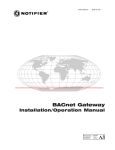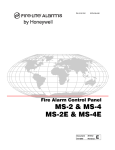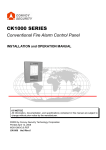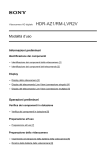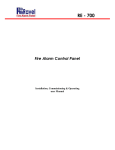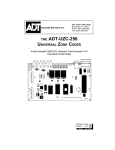Download Honeywell CHG-120 User's Manual
Transcript
Fire Control Instruments 14-16 Southwest Park Westwood, MA 02090, USA Phone: (781) 471-3000 FAX: (781) 471-3099 CHG-120 Battery Charger Instruction Manual FCI P/N 9000-0572 Document 52459 11/22/04 PN 52459:A Revision: ECN 04-691 A Fire Alarm System Limitations While a fire alarm system may lower insurance rates, it is not a substitute for fire insurance! An automatic fire alarm system–typically made up of smoke detectors, heat detectors, manual pull stations, audible warning devices, and a fire alarm control with remote notification capability–can provide early warning of a developing fire. Such a system, however, does not assure protection against property damage or loss of life resulting from a fire. Heat detectors do not sense particles of combustion and alarm only when heat on their sensors increases at a predetermined rate or reaches a predetermined level. Rate-of-rise heat detectors may be subject to reduced sensitivity over time. For this reason, the rate-of-rise feature of each detector should be tested at least once per year by a qualified fire protection specialist. Heat detectors are designed to protect property, not life. The Manufacturer recommends that smoke and/or heat detectors be located throughout a protected premise following the recommendations of the current edition of the National Fire Protection Association Standard 72 (NFPA 72), manufacturer's recommendations, State and local codes, and the recommendations contained in the Guide for Proper Use of System Smoke Detectors, which is made available at no charge to all installing dealers. A study by the Federal Emergency Management Agency (an agency of the United States government) indicated that smoke detectors may not go off in as many as 35% of all fires. While fire alarm systems are designed to provide early warning against fire, they do not guarantee warning or protection against fire. A fire alarm system may not provide timely or adequate warning, or simply may not function, for a variety of reasons: Smoke detectors may not sense fire where smoke cannot reach the detectors such as in chimneys, in or behind walls, on roofs, or on the other side of closed doors. Smoke detectors also may not sense a fire on another level or floor of a building. A second-floor detector, for example, may not sense a first-floor or basement fire. Particles of combustion or "smoke" from a developing fire may not reach the sensing chambers of smoke detectors because: • Barriers such as closed or partially closed doors, walls, or chimneys may inhibit particle or smoke flow. • Smoke particles may become "cold," stratify, and not reach the ceiling or upper walls where detectors are located. • Smoke particles may be blown away from detectors by air outlets. • Smoke particles may be drawn into air returns before reaching the detector. The amount of "smoke" present may be insufficient to alarm smoke detectors. Smoke detectors are designed to alarm at various levels of smoke density. If such density levels are not created by a developing fire at the location of detectors, the detectors will not go into alarm. Smoke detectors, even when working properly, have sensing limitations. Detectors that have photoelectronic sensing chambers tend to detect smoldering fires better than flaming fires, which have little visible smoke. Detectors that have ionizing-type sensing chambers tend to detect fast-flaming fires better than smoldering fires. Because fires develop in different ways and are often unpredictable in their growth, neither type of detector is necessarily best and a given type of detector may not provide adequate warning of a fire. Smoke detectors cannot be expected to provide adequate warning of fires caused by arson, children playing with matches (especially in bedrooms), smoking in bed, and violent explosions (caused by escaping gas, improper storage of flammable materials, etc.). LimWarLg.p65 01/10/2000 IMPORTANT! Smoke detectors must be installed in the same room as the control panel and in rooms used by the system for the connection of alarm transmission wiring, communications, signaling, and/or power. If detectors are not so located, a developing fire may damage the alarm system, crippling its ability to report a fire. Audible warning devices such as bells may not alert people if these devices are located on the other side of closed or partly open doors or are located on another floor of a building. Any warning device may fail to alert people with a disability or those who have recently consumed drugs, alcohol or medication. Please note that: • Strobes can, under certain circumstances, cause seizures in people with conditions such as epilepsy. • Studies have shown that certain people, even when they hear a fire alarm signal, do not respond or comprehend the meaning of the signal. It is the property owner's responsibility to conduct fire drills and other training exercise to make people aware of fire alarm signals and instruct them on the proper reaction to alarm signals. • In rare instances, the sounding of a warning device can cause temporary or permanent hearing loss. A fire alarm system will not operate without any electrical power. If AC power fails, the system will operate from standby batteries only for a specified time and only if the batteries have been properly maintained and replaced regularly. Equipment used in the system may not be technically compatible with the control. It is essential to use only equipment listed for service with your control panel. Telephone lines needed to transmit alarm signals from a premise to a central monitoring station may be out of service or temporarily disabled. For added protection against telephone line failure, backup radio transmission systems are recommended. The most common cause of fire alarm malfunction is inadequate maintenance. To keep the entire fire alarm system in excellent working order, ongoing maintenance is required per the manufacturer's recommendations, and UL and NFPA standards. At a minimum, the requirements of Chapter 7 of NFPA 72 shall be followed. Environments with large amounts of dust, dirt or high air velocity require more frequent maintenance. A maintenance agreement should be arranged through the local manufacturer's representative. Maintenance should be scheduled monthly or as required by National and/ or local fire codes and should be performed by authorized professional fire alarm installers only. Adequate written records of all inspections should be kept. Installation Precautions Adherence to the following will aid in problem-free installation with long-term reliability: WARNING - Several different sources of power can be connected to the fire alarm control panel. Disconnect all sources of power before servicing. Control unit and associated equipment may be damaged by removing and/or inserting cards, modules, or interconnecting cables while the unit is energized. Do not attempt to install, service, or operate this unit until this manual is read and understood. Like all solid state electronic devices, this system may operate erratically or can be damaged when subjected to lightning-induced transients. Although no system is completely immune from lightning transients and interferences, proper grounding will reduce susceptibility. Overhead or outside aerial wiring is not recommended, due to an increased susceptibility to nearby lightning strikes. Consult with the Technical Services Department if any problems are anticipated or encountered. CAUTION - System Reacceptance Test after Software Changes. To ensure proper system operation, this product must be tested in accordance with NFPA 72 Chapter 7 after any programming operation or change in site-specific software. Reacceptance testing is required after any change, addition or deletion of system components, or after any modification, repair or adjustment to system hardware or wiring. All components, circuits, system operations, or software functions known to be affected by a change must be 100% tested. In addition, to ensure that other operations are not inadvertently affected, at least 10% of initiating devices that are not directly affected by the change, up to a maximum of 50 devices, must also be tested and proper system operation verified. This system meets NFPA requirements for operation at 0-49° C/32-120° F and at a relative humidity of 85% RH (noncondensing) at 30° C/86° F. However, the useful life of the system's standby batteries and the electronic components may be adversely affected by extreme temperature ranges and humidity. Therefore, it is recommended that this system and all peripherals be installed in an environment with a nominal room temperature of 15-27° C/60-80° F. Verify that wire sizes are adequate for all initiating and indicating device loops. Most devices cannot tolerate more than a 10% I.R. drop from the specified device voltage. Disconnect AC power and batteries prior to removing or inserting circuit boards. Failure to do so can damage circuits. Remove all electronic assemblies prior to any drilling, filing, reaming, or punching of the enclosure. When possible, make all cable entries from the sides or rear. Before making modifications, verify that they will not interfere with battery, transformer, and printed circuit board location. Do not tighten screw terminals more than 9 in-lbs. Over-tightening may damage threads, resulting in reduced terminal contact pressure and difficulty with screw terminal removal. Though designed to last many years, system components can fail at any time. This system contains static-sensitive components. Always ground yourself with a proper wrist strap before handling any circuits so that static charges are removed from the body. Use static-suppressive packaging to protect electronic assemblies removed from the unit. Follow the instructions in the installation, operating, and programming manuals. These instructions must be followed to avoid damage to the control panel and associated equipment. FACP operation and reliability depend upon proper installation by authorized personnel. FCC Warning WARNING: This equipment generates, uses, and can radiate radio frequency energy and if not installed and used in accordance with the instruction manual, may cause interference to radio communications. It has been tested and found to comply with the limits for class A computing device pursuant to Subpart B of Part 15 of FCC Rules, which is designed to provide reasonable protection against such interference when operated in a commercial environment. Operation of this equipment in a residential area is likely to cause interference, in which case the user will be required to correct the interference at his own expense. Canadian Requirements This digital apparatus does not exceed the Class A limits for radiation noise emissions from digital apparatus set out in the Radio Interference Regulations of the Canadian Department of Communications. Le present appareil numerique n'emet pas de bruits radioelectriques depassant les limites applicables aux appareils numeriques de la classe A prescrites dans le Reglement sur le brouillage radioelectrique edicte par le ministere des Communications du Canada. LimWarLg.p65 01/10/2000 Notes Table of Contents Introduction to the Charger ....................................................................................... 1 Overview................................................................................................................... 1 Specifications ............................................................................................................ 2 Compliance with NFPA Codes and UL Standards ................................................... 2 Charger Maintenance ................................................................................................ 2 Installing the Charger ................................................................................................. 3 Overview................................................................................................................... 3 Installation Precautions and Standards ..................................................................... 3 Battery Precautions............................................................................................... 3 Installation Standards............................................................................................ 4 Charger Connections, Jumpers, and Switches .......................................................... 4 Connecting AC Power to the Charger ...................................................................... 5 Connecting Batteries to the Charger ......................................................................... 6 Mounting the Charger ............................................................................................... 8 Mounting the Charger into a CAB-X3 Series Cabinet ......................................... 8 Mounting the Charger into a BB-55 Battery Box................................................. 9 Connecting the Charger to a Load .......................................................................... 10 Connecting the Charger to a Multiple Load ....................................................... 10 Adding the Charger for Additional Current.........................................................11 Configuring the Charger ......................................................................................... 12 Delay loss of AC Reporting................................................................................ 12 Disable Ground Fault Detection ......................................................................... 12 Trouble and Form-C Relay Connections (Optional) .............................................. 13 Installing Optional Meters ...................................................................................... 14 Installing an AM-1.............................................................................................. 14 Installing a VM-1................................................................................................ 14 Operating the Charger.............................................................................................. 15 Overview................................................................................................................. 15 Starting the Charger ................................................................................................ 15 Understanding the LED Status Indicators............................................................... 15 Normal Operation ................................................................................................... 16 CHG-120 Instruction 11/22/04 PN: 52459:A FCI P/N:9000-0572 v Notes vi CHG-120 Instruction 11/22/04 PN: 52459:A FCI P/N:9000-0572 1. Introduction to the Charger Overview Note: Throughout this manual, the term “charger” refers to a CHG-120. The CHG-120 battery charger is designed to charge lead-acid batteries that provide emergency standby power for a Fire Alarm Control Panel (FACP). Two 12-volt batteries are always used in series to supply 24 VDC nominal. The following list gives answers to some common questions about the charger: • What types of FACPs can be used with the charger? Any 24 VDC FACP that uses lead-acid 25 AH to 120 AH batteries and that has the feature to disable the FACP battery charger. • Where does the charger mount? You can mount the charger into a CAB-X3 Series Cabinet or into a BB-55 Battery Box. • How many outputs does the charger provide? The charger provides two output circuits for connection to multiple loads (such as a power supply, amplifier, auxiliary amplifier, and so forth). • What options are available with the charger? You can configure the charger to disable the charger’s ground fault detection, to delay AC loss reporting (8 or 16 hours), and to operate with 120 VAC or 240 VAC. • How long does it take the charger to charge batteries? Typically, it takes 9 hours to charge 25 AH batteries, 20 hours to charge 60 AH batteries, and up to 48 hours to charge 120 AH batteries. Refer to “Specifications” on page 2 for details. Figure 1 identifies features of the charger: Note: For detailed descriptions of charger connections, jumpers, and switches, see “Charger Connections, Jumpers, and Switches” on page 4. Heavy duty primary AC power connections Nine LED status indicators Open collector trouble daisy chain connections Voltage Selection Switch for 120 VAC or 240 VAC operation External trouble input Form-C trouble relay to other devices Two output circuits to load (power supply, auxiliary power supply, amplifiers, etc.) 15 A replaceable fuses provide short circuit and overload protection 25 AH – 120 AH battery connections Optional Ammeter connection Figure 1 Charger Features CHG-120 Instruction 11/22/04 PN: 52459:A FCI P/N:9000-0572 1 Introduction to the Charger Specifications The charger also provides the following features: • AM-1 ammeter (0-10A) ordered separately • VM-1 voltmeter (0-50 V) ordered separately • Disable local ground fault detection • Selectable loss of AC delay (8 or 16 hours) Specifications Table 1 contains electrical specifications for the charger: Primary AC power in (TB1) 120 VAC, 60 Hz, 2 A 240 VAC, 50 Hz, 1 A Form-C relay (TB3) 5 A at 30 VDC Float charge voltage 27.6 VDC Maximum charging current 4.5 A Fuses F1-F3 (PN 12057) 15 A Battery sizes 25 AH to 120 AH Charging Time (to charge two fully discharged batteries 25 AH – 9 hours 55 AH/60 AH – 20 hours 120 AH – 38 hours Table 1 Charger Specifications Compliance with NFPA Codes and UL Standards The charger complies with the following standards: • NFPA 72-1993 National Fire Alarm Code • UL 864 Standard for Control Units for Fire Alarm Systems and UL 1481 Power Supplies for Fire Alarm Systems • CAN/ULC-S527-M87 Charger Maintenance The charger does not require regular maintenance. While installing the charger, however, make sure to maintain proper polarity when connecting power leads and battery connections. To ensure optimal operation of the charger, observe the following: Overload and reverse-polarity protection Fuses F1, F2 and F3 (15 A, PN 12057) provide overload and reverse-polarity protection. Replace a blown fuse with a fuse with the same rating and type. Periodic Inspection Periodically inspect the batteries for corrosion and make sure that corrosive effects to the batteries do not affect the charger or cabinet. Troubleshooting Most problems with a charger are due to faulty batteries or loose connections. If you encounter problems, inspect the charger, the battery, and all connections for loose wiring or short circuits. Replacing Batteries Only replace batteries with the same charge rate and capacity as other batteries in the set. For example, if replacing one of four 60 AH batteries, make sure the replacement battery has the same charge rate and capacity as the other three batteries. 2 CHG-120 Instruction 11/22/04 PN: 52459:A FCI P/N:9000-0572 2. Installing the Charger Overview This section contains instructions and illustrations for installing the charger, divided into the following topics: Section Topic(s) Covered Page Installation Precautions and Standards Precautions to take when installing the charger and recommended installation standards. 3 Charger Connections, Jumpers, and Switches Location and references to connections, jumpers, and switches used to configure, maintain, and operate the charger. 4 Connecting AC Power to the Charger How to connect AC power to the charger. 5 Connecting Batteries to the Charger How to connect batteries to the charger in two configurations: using two batteries and using four batteries. 6 Mounting the Charger How to mount the charger to a CAB-X3. How to mount the charger to a BB-55. 8 Connecting the Charger to a Load Instructions and illustrations for wiring a charger to a multiple load and for wiring a charger for a large system installation. 10 Configuring the Charger Configuring the charger for the following options: Delaying loss of AC reporting (DACT); and Disabling ground fault detection 12 Trouble and Form-C Relay Connections (Optional) Instructions and illustrations for connecting the following: Open Collector Trouble In (JP5) Trouble Out (JP4) Master Trouble In (JP6) Form-C Trouble Relay (TB3) 13 Installing Optional Meters How to install an optional ammeter, voltmeter, or both. 14 Table 2 Installation Topics Installation Precautions and Standards ! Battery Precautions When installing the charger, observe the following precautions: Observe polarity when making connections. Do not connect the Battery Interconnect Cable until instructed. Batteries, although sealed, contain hazardous acid chemicals. Charging batteries can cause flammable hydrogen gas. Take care when handling batteries: batteries are heavy—take care in lifting and handling them. Mounting batteries requires proper mounting hardware. Follow the battery manufacture’s installation instructions CHG-120 Instruction 11/22/04 PN: 52459:A FCI P/N:9000-0572 3 Installing the Charger Charger Connections, Jumpers, and Switches Installation Standards An installer should be familiar with the following standards: • NEC Article 300 Wiring Methods. • NEC Article 760 Fire Protective Signaling Systems. • Applicable Local and State Building Codes. • Requirements of the Authority Having Jurisdiction. Charger Connections, Jumpers, and Switches LED Status Indicators – Nine LEDs to indicate status of the charger (see “Understanding the LED Status Indicators” on page 15) TB1 – AC Power (120 VAC or 240 VAC (see “Connecting AC Power to the Charger” on page 5) AC Primary On Charger Trouble Earth Ground Fault Hi Charge Lo Charge 27V (battery voltage >27 VDC) 25V (battery voltage between 25-27 VDC) 23V (battery voltage between 23-25 VDC) Low Battery (battery less than 23 VDC) Figure 2 show all connections, jumpers, and switches needed to maintain, configure, and operate the charger: JP4 – Open Collector Trouble Out and JP5 – Open Collector Trouble In (see “Trouble and Form-C Relay Connections (Optional)” on page 13) JP6 – Master Trouble In (see “Trouble and Form-C Relay Connections (Optional)” on page 13) TB3 – Form-C Trouble Relay (see “Trouble and Form-C Relay Connections (Optional)” on page 13) TB2 – Output Circuits 1 and 2 (see “Connecting the Charger to a Load” on page 10) SW1 – Voltage Selection Switch for selecting 120 VAC or 240 VAC operation (See Figure 3 on page 5) TB2 – Battery Connections (see “Connecting Batteries to the Charger” on page 6) Resistor R104 – Cut to disable ground fault detection (refer to “Disable Ground Fault Detection” on page 12) Resistor R100 – Used with JP8 to delay loss of AC reporting (refer to “Delay loss of AC Reporting” on page 12) Fuses F1, F2, and F3 – Replaceable plugged fuses (see “Charger Maintenance” on page 2) JP3 (AM-1 connector) and JP9 for enabling an optional AM-1 ammeter. (see “Installing an AM-1” on page 14) Figure 2 Charger Connections, Switches, and Jumpers 4 CHG-120 Instruction 11/22/04 PN: 52459:A FCI P/N:9000-0572 Connecting AC Power to the Charger Installing the Charger Connecting AC Power to the Charger Caution: Before connecting AC power to the charger—make sure to set the Voltage Select Switch (SW1) on the charger (Figure 2) to match your AC power source (120 VAC or 240 VAC). Figure 3 shows the voltage selection positions for SW1: Note: The charger is rated for 120 VAC or 240 VAC operation. Therefore, 115V on SW1 indicates 120 VAC operation; and 230V, indicates 240 VAC operation. SW1 set to 120 VAC operation SW1 set to 240 VAC operation Figure 3 Using SW1 to Select AC Voltage Figure 4 shows the steps for connecting the charger to the main AC power source. Plastic insulating cover (PN 02114) TB1 Earth ground (EARTH) TB1 Step 1: Remove the plastic insulating cover from TB1. Earth ground (EARTH) Step 2: Connect the Earth ground line to TB1. Primary Hot line in (HOT) Earth ground (EARTH) Neutral line in (NUTRL) Neutral line in (NUTRL) TB1 TB1 Step 3: Connect the Primary Neutral line to TB1. Step 4: Connect the Primary Hot line to TB1. Check all connections, then replace the plastic insulating cover. Figure 4 Connecting AC Power to the Charger CHG-120 Instruction 11/22/04 PN: 52459:A FCI P/N:9000-0572 5 Installing the Charger Connecting Batteries to the Charger Connecting Batteries to the Charger Overview you can connect 25 AH –120 AH batteries to the charger. This section provides illustrations and instructions for connecting two batteries or for connecting four batteries. Connecting Two Batteries Figure 5 shows how to connect two 25 AH batteries to the charger: TB1 TB2 ! CHG-120 Warning: Do not connect the Battery Interconnect Cable at this time. Power Supply Refer to “Starting the Charger” on page 15. Figure 5 Connecting 25 AH Batteries Table 3 contains instructions for connecting batteries to the charger: Step Action 1 Remove all power sources to the charger. 2 Connect the battery negative cable to the TB2 terminal (on the charger labeled “Battery –” as shown in Figure 5. 3 Connect the battery positive cable to the TB2 terminal (on the charger) labeled “Battery +” as shown in Figure 5. 4 Proceed to the section “Connecting the Charger.” Do not connect the Battery Interconnect Cable at this time—refer to “Starting the Charger” on page 15. Table 3 Connecting 25 AH Batteries 6 CHG-120 Instruction 11/22/04 PN: 52459:A FCI P/N:9000-0572 Connecting Batteries to the Charger Installing the Charger Connecting Four Batteries Figure 6 shows how to connect four 55 AH batteries to the charger: TB1 TB2 ! Warning: Do not connect the Battery Interconnect Cable at this time. Charger Power Supply Refer to “Starting the Charger” on page 15. Figure 6 Connecting Four Batteries to a Charger Table 4 contains instructions for connecting four batteries to the charger: Step Action 1 Remove all power sources to the charger. 2 Tie the batteries in pairs by connecting the battery negative terminals and the battery positive terminals as shown in Figure 6. 3 Connect the battery negative cable to the TB2 terminal (on the charger labeled “Battery –”) as shown in Figure 6. 4 Connect the battery positive cable to the TB2 terminal (on the charger) labeled “Battery +”) as shown in Figure 6. 5 Proceed to the section “Connecting the Charger.” Do not connect the Battery Interconnect Cable at this time—refer to “Starting the Charger” on page 15. Table 4 Connecting 55 AH Batteries CHG-120 Instruction 11/22/04 PN: 52459:A FCI P/N:9000-0572 7 Installing the Charger Mounting the Charger Mounting the Charger Mounting the Charger into a CAB-X3 Series Cabinet You can mount a charger into the bottom row of a CAB-X3 Series Cabinet, as long as the charger is within 20 feet of the load. Typically, a charger mounts into the lower right corner of the CAB-X3—beside the power supply (Figure 7, position 2). If using an additional CAB-X3, you can mount the charger in the lower left corner (Figure 7, position 2). Figure 7 shows the two mounting positions of a charger into a CAB-X3. Mounting hooks Position 1: Lower right corner. Position 2: Lower left corner. Figure 7 Mounting a Charger into a CAB-X3 (CAB-C3 shown) To mount a charger into a CAB-X3 Series Cabinet, follow these instructions: Step Action 1 Place the charger chassis mounting slots in line with the mounting holes in the cabinet. If mounting in position 2, place the charger chassis onto the mounting hooks in the cabinet. 2 Insert the self-tapping screws through the charger chassis mounting slots and into the mounting holes in the cabinet. Chassis mounting slot Self-tapping screw 3 8 Tighten the self-tapping screws. CHG-120 Instruction 11/22/04 PN: 52459:A FCI P/N:9000-0572 Mounting the Charger Installing the Charger Mounting the Charger into a BB-55 Battery Box You can also mount a charger into a BB-55 battery box, as long as the BB-55 is within 20 feet of the load. Note that a charger takes up half the space of the BB-55. This means you only have room left for two 25 AH batteries in the BB-55. Figure 8 shows the mounting position of a charger in a BB-55. Optional bracket for mounting an optional AM-1 or VM-1 Self-tapping screws Figure 8 Mounting a Charger into a BB-55 To mount a charger into a BB-55 battery box, follow these instructions: Step Action 1 Place the charger chassis mounting slots in line with the mounting holes in the BB-55. 2 Insert the self-tapping screws through the charger chassis mounting slots and into the mounting holes in the BB-55. Self-tapping screw 3 Chassis mounting slot Tighten the self-tapping screws. CHG-120 Instruction 11/22/04 PN: 52459:A FCI P/N:9000-0572 9 Installing the Charger Connecting the Charger to a Load Connecting the Charger to a Load This section provides two applications for connecting a charger to a load. While connecting a charger to a load, observe the following precautions: • Make sure all power sources are off to the charger and the load. • Follow polarity when making connections. Connecting the Charger to a Multiple Load You can connect a charger to multiple loads, such as a main power supply, auxiliary power supply, amplifiers, and so forth, as shown in Figure 9. Power Supply Note: Figure 10 shows a wiring diagram for tying the load to battery terminals to obtain additional current. For example, the first AA-120 draws 7 A, the daisy-chained Generic Audio Amplifiers draw 7 A, and the second AA-120 draws 7 A of additional current from the batteries. CHG-120 Generic Audio Amplifier Figure 9 Typical Wiring for a Charger to a Multiple Load To connect a charger as shown in Figure 9, follow these steps: 10 Step Action 1 Connect the battery+ and battery– terminals of the power supply to the charger output circuit (TB2: Out 1+ and Out 1–) as shown in Figure 9. 2 Connect the battery+ and battery– terminals of the amplifier to the charger output circuit (TB2: Out 2+ and Out 2–) as shown in Figure 9. 3 Connect the batteries to the charger (for battery connections see Figure 5 or Figure 6). CHG-120 Instruction 11/22/04 PN: 52459:A FCI P/N:9000-0572 Connecting the Charger to a Load Installing the Charger Adding the Charger for Additional Current Due to internal fuses, the maximum alarm current that can be drawn from the batteries and passed through the charger’s two output circuits is limited to 10 amps maximum (each circuit). The PS-12600 batteries, however, are capable of supplying up to 45 amps of current in alarm. The remaining 25 amps of alarm current can be drawn directly from the battery terminals to supply Notification Appliance Circuits, control modules and other alarm devices as illustrated in Figure 10: First AA-120 Power Supply Charger First Generic Audio Amp 55 AH/60 AH 12 VDC 55 AH/60 AH 12 VDC 55 AH/60 AH 12 VDC 55 AH/60 AH 12 VDC Second Generic Audio Amp Second AA-120 Figure 10 Typical Connections for Drawing Additional Current To connect a charger as shown in Figure 10, follow these steps: Step Action 1 Connect the Battery+ and Battery– terminals of the power supply to the charger Battery output (TB2: Batt 1+ and Batt 1–) as shown in Figure 10. 2 Connect the Battery+ and Battery– terminals of the first AA-120 to the charger output circuit (TB2: Out 2+ and Out 2–) as shown Figure 10. 3 Connect the Battery+ and Battery– terminals of the first Generic Audio Amp to the charger output circuit (TB2: Out 1+ and Out 1–) as shown in Figure 10. 4 Connect the Battery+ and Battery– terminals of the second Generic Audio Amp to the Battery+ and Battery– terminals of the first Audio Amp as shown in Figure 10. 5 Connect the Battery+ and Battery– terminals of the second AA-120 to the batteries as shown in Figure 10. 6 Connect the batteries to the charger. CHG-120 Instruction 11/22/04 PN: 52459:A FCI P/N:9000-0572 11 Installing the Charger Configuring the Charger Configuring the Charger You can configure the charger to do the following: • Set the charger input power (see Figure 3 on page 5). • Delay AC loss reporting (for Central Station applications); and • Disable charger ground fault detection. Figure 11 shows how to configure the charger for delaying the loss of AC reporting and for disabling ground fault detection: Disable ground fault detection cut and remove R104 Delay loss of AC (16 hrs) cut and remove R100, in addition to cutting JP8 Delay loss of AC (8 hrs) cut JP8 Figure 11 Configuring the Charger Delay loss of AC Reporting If using a Digital Alarm Communicator (DACT), you must delay the reporting of an AC loss condition to a central station. This delays activation of the trouble bus and Form-C trouble contacts when AC fails. You can configure the charger for an 8-hour or a 16-hour delay as follows: • 8-hour delay – Cut and remove jumper JP8 on the charger (Figure 11). • 16-hour delay – Cut jumper JP8; then, cut and remove resistor R100 (Figure 11). Disable Ground Fault Detection To disable local (charger) earth fault detection, cut and remove resistor R104 (Figure 11). Figure 12 contains a simplified block diagram that shows ground fault detection disabled on a charger connected to multiple power supplies: Charger On Power Supply #1, enable ground fault detection. Power Supply #1 On the charger, disable ground fault detection (cut R104). Power Supply #2 Power Supply #3 On Power Supply #2 and #3, disable ground fault detection. Figure 12 Disabling Ground Fault Detection 12 CHG-120 Instruction 11/22/04 PN: 52459:A FCI P/N:9000-0572 Trouble and Form-C Relay Connections (Optional) Installing the Charger Trouble and Form-C Relay Connections (Optional) Table 5 contains descriptions of optional connectors on the charger: Function Connector Use open collector input and output to daisy chain a trouble signal through the charger without affecting charger operation. JP5 Open Collector Trouble In JP4 Open Collector Trouble Out Receive trouble signals from another device, such as a Control Module. JP6 Master Trouble In Transmit a charger trouble signal to another device. TB3 Form-C Trouble Relay Table 5 Charger Trouble and Form-C Relay Connections Figure 13 shows charger trouble and Form-C relay connections: Figure 13 Connections for Optional Devices CHG-120 Instruction 11/22/04 PN: 52459:A FCI P/N:9000-0572 13 Installing the Charger Installing Optional Meters Installing Optional Meters You can also order and install a ammeter (AM-1) or voltmeter (VM-1) for use with the charger. If mounting an AM-1 or a VM-1, mount the meter to a BB-55 as shown in Figure 14. Table 6 contains descriptions and part numbers for these optional meters: Item Part Number Description Ammeter AM-1 0-10 A ammeter with a 3-ft. cable for connection to the charger (JP3). Mounts into a BB-55 battery box only. Voltmeter VM-1 0-50 V voltmeter with 3-ft. positive and negative leads for connection to the charger output circuit. Mounts into a BB-55 battery box only. Table 6 Optional Meters Installing an AM-1 To install an AM-1, follow these steps: 1. Cut jumper JP9 on the charger (Figure 13). 2. Connect the AM-1 harness to JP3 on the charger (Figure 11)—making sure to observe proper polarity. 3. Mount the AM-1 into a mounting slot on the front of the BB-55 (Figure 14): AM-1 or VM-1 (BB-55 only) BB-55 Mounting Slot Figure 14 Mounting an AM-1 or VM-1 to a BB-55 Battery Box Installing a VM-1 You can connect a VM-1 across a charger output circuit. For example, to install a VM-1 to measure voltage from charger output circuit 1, follow these steps: 14 1. Connect the positive lead to TB2 Out 1 (+). See Figure 13. 2. Connect the negative lead to TB2 Out 1 (–). SeeFigure 13. 3. Mount the VM-1 into a mounting slot on the front of the BB-55 battery box. CHG-120 Instruction 11/22/04 PN: 52459:A FCI P/N:9000-0572 3. Operating the Charger Overview This section contains information on starting the charger, interpreting the LED Status Indicators on the charger, and normal operation of the charger. Starting the Charger ! Warning: Before starting the charger, do the following: Follow the installation instructions in Section 2, “Installing the Charger.” Verify proper polarity on all connections between the charger and the batteries, load, and optional meters. Make sure there are no short circuits between leads and between battery terminals. Make sure the Battery Interconnect Cable(s) is not connected. To start the charger, follow these steps: 4. Connect AC power to the charger. The AC On LED and Trouble LED go on. 5. Connect the batteries to the charger 6. Connect the Battery Interconnect Cable. The Trouble LED goes off. 7. Connect the charger to the load (such as a power supply, an amplifier, and so on). Understanding the LED Status Indicators The charger provides nine LED Status Indicators, which are identified in Figure 15. Also refer to Table 7 for conditions, such as troubles, that cause LEDs to light. AC On Primary AC on Trouble Charger in trouble condition (see Table 7) Ground Fault Earth fault condition detected HI Charge Charging current greater than 400 mA LO Charge Charging current less than 400 mA (loss of AC) 27V Battery voltage greater than 27 VDC 25V Battery voltage between 25-27 VDC 23V Battery voltage between 23-25 VDC Low Battery Battery voltage less than 23 VDC Green LED Yellow LED Figure 15 LED Status Indicators CHG-120 Instruction 11/22/04 PN: 52459:A FCI P/N:9000-0572 15 Operating the Charger Normal Operation H H H H H H H Trouble (Master Trouble In JP6 connected) Faulty Battery (or less the 21 V) H Trouble (with AC Trouble Delay used) Short Circuit H Trouble Ground Fault H Disconnected Battery AC On AC Trouble LED Normal Operation Table 7 shows the conditions that cause the charger LEDs to come on: H H H H Ground Fault HI Charge I I LO Charge (Loss of AC) I H 27 V I I 25 V I 23 V Low Battery I I H I I H I H I I I I I I I I I I I I I I I I I I H H Legend: H LED on. I LED on or off, depending on battery voltage. Refer to “Normal Operation.” Table 7 LED Status Indicators Normal Operation The CHG-120 charges batteries at 4.5 A. When batteries are fully charged, the charger maintains a float charge of 27.6 VDC at a trickle charge rate of less than 400 mA. While charging the batteries, the HI and LO Charge LEDs switch on and off approximately every 20 seconds. Also, one of the 23 V, 25 V, 27 V, or Low Battery LEDs also comes on, depending on the battery voltage. 16 CHG-120 Instruction 11/22/04 PN: 52459:A FCI P/N:9000-0572 Index A AC loss reporting 1, 4, 12 AC Power 4 AC power connections 5 AM-1 installation 14 AM-1 ammeter 2 AM-1 connector 4 B batteries 1 battery 25 AH connection 6 connecting four 7 battery charger 1 battery connections 4, 6 battery replacement 2 battery sizes 2 C charger 1 additional current 11 connecting to FACP 11 connecting to load 10 connecting to multiple load 10 operation 15 starting 15 Charger Maintenance 2 charger voltage 2 charging current 2 Charging Time 2 compatibility 1 configuring charger 12 connections 4 F FACP compatibility 1 Features 1 Fuses 2 fuses 4 G ground fault detection 1, 4, 12 I inspection 2 installation 3 precautions 3 standards 4 J jumpers 4 L LED status 16 CHG-120 Instruction 11/22/04 PN: 52459:A FCI P/N:9000-0572 LED status indicators 4, 15 M meters installation 14 mounting 1 BB-55 9 CAB-X3 8 N NFPA Codes 2 normal operation 16 O operation 15 normal 16 options 1 outputs 1, 4 Overview 1 P Precautions 3 primary power 1, 2 protection overload & reverse-polarity 2 R relay 2, 4 connections 13 S Specifications 2 starting charger 15 switches 4 T trouble connections 13 Trouble In 4 Trouble Out 4 troubleshooting 2 U UL Standards 2 V VM-1 installation 14 VM-1 voltmeter 2 Voltage Select Switch 5 voltage selection 4 17 Limited Warranty The manufacturer warrants its products to be free from defects in materials and workmanship for eighteen (18) months from the date of manufacture, under normal use and service. Products are date-stamped at time of manufacture. The sole and exclusive obligation of the manufacturer is to repair or replace, at its option, free of charge for parts and labor, any part which is defective in materials or workmanship under normal use and service. For products not under the manufacturer's date-stamp control, the warranty is eighteen (18) months from date of original purchase by the manufacturer's distributor unless the installation instructions or catalog sets forth a shorter period, in which case the shorter period shall apply. This warranty is void if the product is altered, repaired, or serviced by anyone other than the manufacturer or its authorized distributors, or if there is a failure to maintain the products and systems in which they operate in a proper and workable manner. In case of defect, secure a Return Material Authorization form from our customer service department. Return product, transportation prepaid, to the manufacturer. This writing constitutes the only warranty made by this manufacturer with respect to its products. The manufacturer does not represent that its products will prevent any loss by fire or otherwise, or that its products will in all cases provide the protection for which they are installed or intended. Buyer acknowledges that the manufacturer is not an insurer and assumes no risk for loss or damages or the cost of any inconvenience, transportation, damage, misuse, abuse, accident, or similar incident. THE MANUFACTURER GIVES NO WARRANTY, EXPRESSED OR IMPLIED, OF MERCHANTABILITY, FITNESS FOR ANY PARTICULAR PURPOSE, OR OTHERWISE WHICH EXTEND BEYOND THE DESCRIPTION ON THE FACE HEREOF. UNDER NO CIRCUMSTANCES SHALL THE MANUFACTURER BE LIABLE FOR ANY LOSS OF OR DAMAGE TO PROPERTY, DIRECT, INCIDENTAL, OR CONSEQUENTIAL, ARISING OUT OF THE USE OF, OR INABILITY TO USE THE MANUFACTURER'S PRODUCTS. FURTHERMORE, THE MANUFACTURER SHALL NOT BE LIABLE FOR ANY PERSONAL INJURY OR DEATH WHICH MAY ARISE IN THE COURSE OF, OR AS A RESULT OF, PERSONAL, COMMERCIAL, OR INDUSTRIAL USE OF ITS PRODUCTS. This warranty replaces all previous warranties and is the only warranty made by the manufacturer. No increase or alteration, written or verbal, of the obligation of this warranty is authorized. LimWarLg.p65 01/10/2000
























